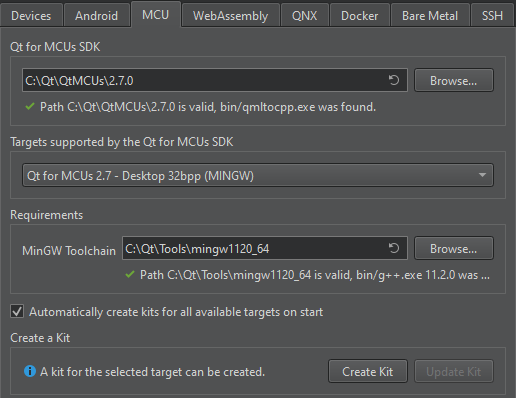Connect MCU devices
Note: Enable the McuSupport plugin to develop for MCUs.
To configure a connection between Qt Creator and your MCU board:
- Go to Preferences > Devices > MCU.
- In Qt for MCUs SDK, specify the path to the directory where you installed Qt for MCUs SDK.

- In Targets supported by the Qt for MCUs SDK, select your MCU board.
- In Requirements, check that the platform-specific requirements are met. This depends on the target:
- For STM32 targets:
- The GNU ARM Embedded Toolchain or IAR ARM Compiler path.
- The STM32CubeProgrammer install path.
- The Board SDK for the chosen target.
- The FreeRTOS Sources for the chosen target.
- For NXP targets:
- The GNU ARM Embedded Toolchain or IAR ARM Compiler path.
- The MCUXpresso IDE install path.
- The Board SDK for the chosen target.
- The FreeRTOS Sources for the chosen target.
- For Renesas targets:
- The Green Hills Compiler path.
- The Renesas Graphics Library path.
- For Infineon targets:
- The Green Hills Compiler for ARM path.
- The Graphics Driver for Traveo II Cluster Series path.
- The Infineon Auto Flash Utility path.
- For STM32 targets:
- Select Automatically create kits for all available targets on start to create kits automatically the next time Qt Creator starts.
Note: Select Create Kit to manually create kits for the target.
- Select Apply to save the preferences.
Add MCU devices
Qt Creator automatically adds a default MCU device when you select Apply in the MCU tab after configuring the MCU toolchain.

To add MCU devices, select Preferences > Devices > Add > MCU Device > Start Wizard:
- In Name, give the device a name.
- In Type, select the board type.
- Select Apply to add the device.
See also Enable and disable plugins, How To: Develop for MCUs, and Developing for MCUs.
© 2024 The Qt Company Ltd. Documentation contributions included herein are the copyrights of their respective owners. The documentation provided herein is licensed under the terms of the GNU Free Documentation License version 1.3 as published by the Free Software Foundation. Qt and respective logos are trademarks of The Qt Company Ltd in Finland and/or other countries worldwide. All other trademarks are property of their respective owners.
